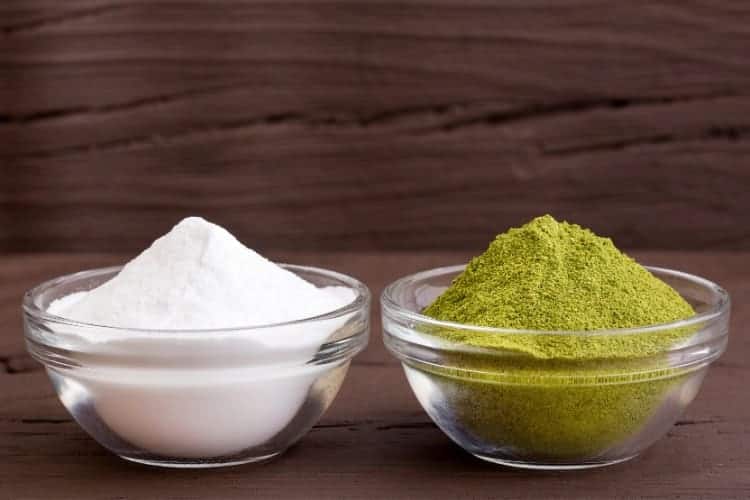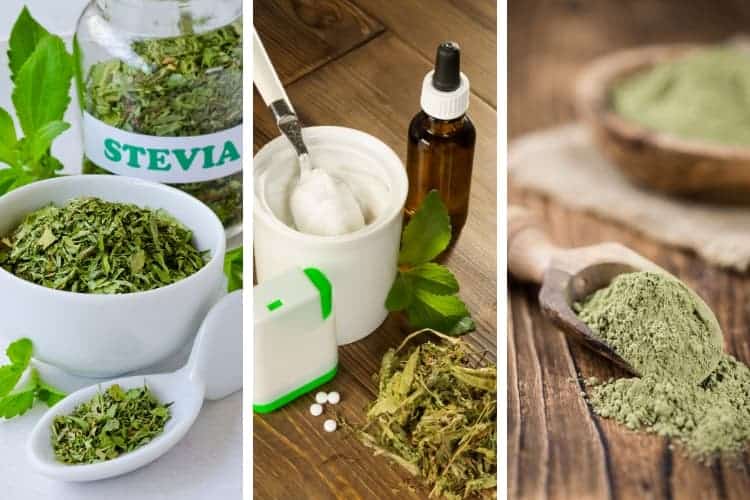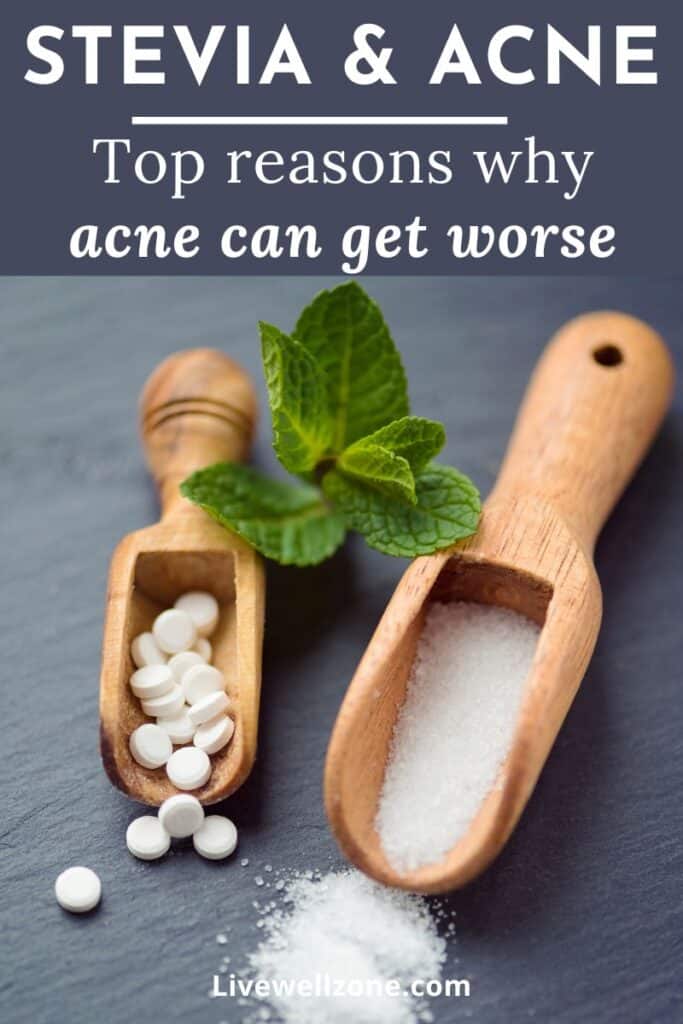
Known as the “sweet herb of Paraguay”, stevia has a popular sweetener alternative, thanks to studies indicating that it helps to lower blood glucose, while also being 200+ time sweeter than regular sugar. For acne sufferers, this sounds like a win-win: you can still eat “sugar” without stressing about blood sugar spikes that can trigger pimples. Yet, the reality, for some people, is that stevia and acne flare ups seem to go hand-in-hand.
But why would that be? Well, that’s what this article is going to attempt to answer for you.
Before we dive in though, I have to state that getting clear cut answers when it comes to the pros and cons of stevia is often tricky, confusing and frustrating.
And it’s mainly because the term stevia is used to refer to the actual plant and commercial stevia sweeteners.
Unfortunately, there are some major differences between the stevia plant and the final product on store shelves.
So, in this article my goal is to simply give you the facts and research that I’ve come across so that you can decide for yourself whether stevia is for you or not.
Overall, we’re going to look at:
- The main differences between the stevia plant and stevia sweeteners.
- The 3 categories of stevia that are available on the market.
- How mainstream stevia sweeteners could potentially worsen acne.
- The right way to use stevia leaf and other natural sweeteners.
GREEN STEVIA LEAF VS STEVIA SWEETENERS FOR ACNE

Stevia comes from the stevia rebaudiana plant which produces green leaves that are naturally sweet, with a slight bitter aftertaste.
According to a report in the Journal of Human Ecology, the whole stevia leaf is only 10 to 15 times sweeter than sucrose (aka white sugar or table sugar) (source).
Now, this is a far cry from commercial stevia sweeteners which are often said to be 200 to 350 times sweeter than sugar.
So, why the huge difference in sweetness?
Well, it all has to do with the extracts that are used in stevia products.
You see, stevia contains several dozens of compounds known as steviol glycosides. These glycosides are responsible for the plant’s sweetness, as well as its slight bitter aftertaste.
Here’s a sample of some steviol glycosides and how they compare to sucrose (source):
| Steviol Glycoside | Sweetness level (compared to regular sugar) |
|---|---|
| Dulcoside A | 50 – 120 times sweeter |
| Rubusoside | 110 times sweeter |
| Steviolbioside | 100 – 125 times sweeter |
| Stevioside | 150 – 300 times sweeter |
| Rebaudioside A | 200 to 400 times sweeter |
| Rebaudioside B | 300 to 350 times sweeter |
| Rebaudioside C | 50 to 100 times sweeter |
Overall, rebaudioside A is the glycoside that is used in most stevia sweeteners. In addition, some products also use stevioside.
The process that many companies use to make commercial stevia sweeteners focuses on separating the glycosides from the other components of stevia (source).
As a result, most stevia sweeteners are not likely to have the full spectrum of nutrients that are in the plant, such as (source):
- Calcium
- Iron
- Sodium
- Potassium
- Fiber
- Protein
- Chlorophyll (gives stevia and all green plants, their green color)
Furthermore, stevia “sugar” is usually white, which further highlights the fact that the plant has gone through significant processing.
Because most stevia sweeteners only contain the sweet components of the plant, it could be that the lack of other nutrients make it unhealthy for the body (similar to any other pure sugar ingredient).
And for anyone who has flare ups with the whole green leaf, it could be an allergic reaction to the plant itself. After all, stevia is part of the ragweed family, so if you’re allergic to ragweed, then consuming stevia could create a variety of issues that extend to the skin (source).
But as with all things related to stevia, there’s a lot more to the story! Additional clues lie in the types of stevia products that are sold to us, which we’re going to look at next.
THE MAIN TYPES OF STEVIA FOR ACNE-PRONE SKIN

There are three types or categories of stevia that are available on the market:
- Purified stevia extract.
- Stevia blends.
- Green stevia leaf.
1. Purified Stevia Extracts
These come in both powder or liquid form and are considered the best quality of stevia sweetener.
If you’re buying the powder form, the only ingredient listed will generally be stevia extract or Reb A or Rebaudiana A.
On the other hand, if you’re getting the liquid form, then the first two ingredients will likely be stevia leaf extract and water. In addition, expect to see other ingredients like:
- Glycerin.
- Some sort of antioxidant or preservative.
- Alcohol.
- Natural flavors (which often contain questionable ingredients).
The above list is by no means exhaustive and the final ingredients will vary depending on the brand.
2. Stevia Blends
These products are a combination of stevia extract and sugar alcohols, like erythritol or xylitol.
Similar to the purified extracts, the final ingredients in stevia blends can vary depending on the brand and the intended use of the product.
For example, a stevia blend that is supposed to be used for baking might include sugar alcohols as well as raw sugar, chicory root, brown sugar, molasses and more.
In addition, some companies even add maltodextrin – a highly refined powder made from some starchy foods – to stevia. This is because maltodextrin gives the stevia product that easy-to-pour quality that regular granulated sugar has.
Unfortunately, though, maltodextrin is horrible when it comes to spiking blood sugar. In fact, it’s glycemic index is high (85-100) which is worse than regular sugar (which has a GI of about 58).
So, in short: always check the ingredients 🙂
In terms of quality, these are the worst because there’s no telling what other ingredients you might be getting.
3. Green Stevia Leaves
If you’re looking for true stevia, this is it. Actual stevia leaves! It’s available in two forms:
- Dried leaves
- Stevia herb powder (dried leaves ground up into a powder)
You can find both of them at a local herb store or from online retailers like Starwest Botanicals, Frontier Co-op or Mountain Rose Herbs.
In terms of using the dried leaves and the powder, they work best for sweetening hot drinks (like herbal tea). In my experience, the following measurements work well:
- 1 teaspoon dried stevia leaf for 1.5 quarts of tea.
- ½ teaspoon stevia leaf powder for 1.5 quarts of tea.
Whether you use the dry leaf or the powder, always make sure to add the stevia into the hot tea, not cold. Just like other herbs, the hot water is necessary to extract the sweetness (and other nutrients) from the stevia leaf.
As you can see, there are some surprising ingredients in stevia sweeteners, some of which are known to contribute to gut issues and inflammation. It’s no wonder some people might break out more when consuming stevia sweeteners.
In the next section, we’re going to look at the research around stevia and how some of those added ingredients might contribute to skin problems.
FAQs ABOUT STEVIA AND ACNE
Is stevia good for gut health?
While stevia itself has not been linked to gut issues, the sugar alcohols that are added to some stevia products may contribute to digestive issues and gut issues as a whole.
By sugar alcohols, I’m referring to things like :
- Erythritol.
- Xylitol.
- Sorbitol
The main thing about these sugar alcohols is that the body cannot digest some of them. So, they end up in the large intestine where the gut bacteria metabolizes them (source).
That’s all well and good if your gut is in good health.
However, this can be problematic for acne sufferers because they may already have underlying gut issues, notably leaky gut and dysbiosis (imbalances in the gut flora).
And if the gut is already out of balance, then these sugar alcohols will simply add more stress to the digestive system. More stress means more cortisol production, which can then increase sebum production and contribute to more breakouts.
Now, as far as the issues that sugar alcohols cause, they can include:
- Bloating.
- Gas.
- Diarrhea.
It’s worth noting that of all the common sugar alcohols, erythritol and xylitol are known to cause fewer digestive issues. But just because they cause fewer issues doesn’t mean they still can’t be problematic if your gut isn’t in tip top shape.
NOTE: some research shows that stevia extracts that contain steviol glycosides are able to kill harmful pathogens like E. coli, but they don’t kill “good” bacteria like bifidobacterium and lactobacillus (source). So, the main takeaway here is that if you’re going to use a stevia extract, it should be a purified extract.
Does stevia spike insulin?
Some studies suggest that stevia increases insulin sensitivity i.e. the cells’ ability to respond to insulin. The more our cells are sensitive to (i.e. respond to) insulin, the easier it is for glucose to enter the cells. Ultimately, this leads to less glucose in the blood.
One thing that’s worth pointing out here is that many of the studies done around stevia and blood sugar were done with dried stevia leaf, not stevia extracts (source).
Is stevia inflammatory?
Research shows that many of the glycosides in the stevia plant have anti-inflammatory and antioxidant properties.
This scientific review paper published in June 2020 provides incredibly detailed information about stevia’s anti-inflammatory properties (and many other health benefits). Interestingly, many of the benefits cited relate to pure stevia extracts. Here’s a summary of some of the data presented in that paper:
- Stevia extracts prevent inflammation and lower oxidative damage to the liver.
- Stevioside reduces inflammation in staph-infected mice.
- Rebaudioside A preserves the expression of Nrf2, which is a protein that controls everything from inflammatory and immune responses, to cognitive function and even, behavior (source)
In addition, this study from 2012 showed that stevioside enhances cancer cell death and also lowers stress pathways (which are also inflammatory pathways) that contribute to the spread of cancer.
Can artificial sweeteners cause breakouts?
Some studies, such as this one done with mice, suggest that artificial sweeteners can spike blood sugar. Since increases in blood sugar are tightly linked to sebum production and acne, artificial sweeteners could trigger a reaction that eventually leads to breakouts.
WHAT IS A GOOD NATURAL SUGAR SUBSTITUTE FOR PIMPLES?

If you’d like to step away from stevia completely, there are several natural sugar options that are suitable for acne-prone skin. These include honey, date sugar and maple syrup.
1. Raw Honey
Honey is definitely the top natural sugar option for anyone struggling with acne because it contains a variety of vitamins, minerals and even, amino acids.
Now, do bear in mind that the exact nutrients in honey depends on the plants that the bees feed on.
So, from one country to another, or even from one town to another, the nutritional composition of honey can vary a lot.
But as long as you choose raw, unpasteurized honey, you’ll be getting the nutritional benefits.
And as a bonus, honey works great as a face mask or a spot treatment for pimples!
2. Whole Dates and Date Sugar
Not only are dates naturally sweet, but they’re full of fiber, vitamin C, vitamin A, B-vitamins, iron and other nutrients.
As for date sugar, it’s made from dehydrated dates that have been ground into fine particles. So, it still has some of the nutrients that are naturally present in dates.
Short of using whole dates, date sugar is an awesome alternative if you want granulated sugar that is still fairly wholesome.
3. Pure Maple Syrup
From a nutritional perspective, maple syrup ranks lower than raw honey and date sugar. Nonetheless, it’s a natural sugar alternative that has been around for ages.
Just make sure to check the label and ensure that the only ingredient is maple syrup. There should be no fillers, such as high fructose corn syrup, lurking in there!
SO IN CONCLUSION, IS STEVIA BAD FOR ACNE?
Research on the green stevia leaf and purified stevia extracts suggests that they’re anti-inflammatory, increase insulin sensitivity and regulate blood sugar. These properties are generally beneficial for anyone struggling with acne. However, stevia blends that contain other additives like sugar alcohols or maltodextrin, could be more problematic for acne-prone skin.
This article may have raised more questions than it answered. However, I also hope that it’s helped you get a better understanding of the science – and the marketing – around stevia.

You Might Also Enjoy:
10 Healthy Homemade Drinks for Clear Skin (that you need to know!)
Everything You Need To Know About Chamomile Tea vs Green Tea for Acne
Vegan (& Vegetarian) Meal Plan for Clear Skin: Fun, Easy, Tasty Recipes!
Spearmint Tea vs Spironolactone for Acne: Pros and Cons | Is One Better Than The Other?
Does Inflammation In the Body Cause Acne?
Why Is My Skin Bad When I Eat Healthy? 8 Reasons You May Not Have Considered
Is Chamomile Tea Good For Acne?
How To Make The Best Anti-Acne Smoothie To Give Your Skin New Life
Seed Cycling for Acne: Benefits and How To Get Started
How Much Water Should I Drink To Clear Acne? The Answer May Surprise You

